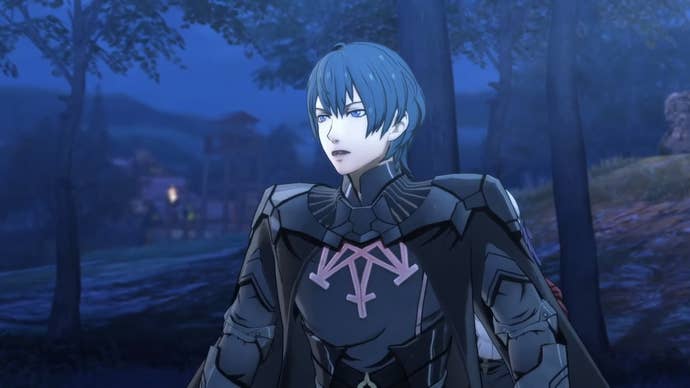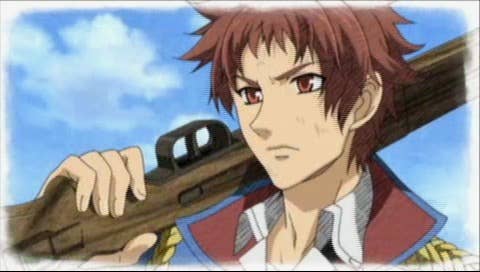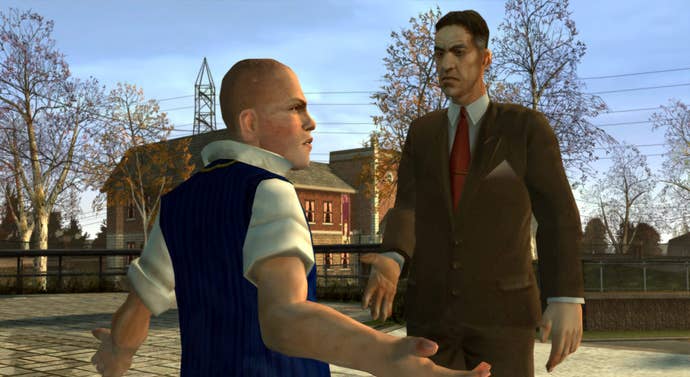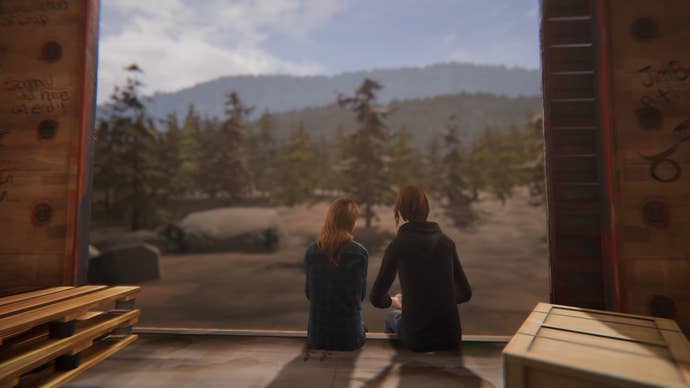How Does Fire Emblem: Three Houses Stack Up Against Persona, Bully, and Other Games With School Settings?
We don't need no education, but video game characters are another story.
This article first appeared on USgamer, a partner publication of VG247. Some content, such as this article, has been migrated to VG247 for posterity after USgamer's closure - but it has not been edited or further vetted by the VG247 team.
A couple years ago, I finally got around to watching Buffy: The Vampire Slayer after unfortunately missing it during its 90s heyday. I was delighted to discover what was basically a live-action anime; one where superpowered teens attended school by day and battled evil by night. It was the sort of timeless setting that will always be popular, as we're seeing with Fire Emblem: Three Houses right now.
Why are stories like Buffy so successful? Because they speak to kids who fear the pressure of high school; teens who are living it, and adults who miss it. They're convenient shorthand for growing up; Joss Whedon even said the idea behind Buffy was, "What if high school were literally hell?"
Video games are no different. Multiple franchises, from Bully to Valkyria Chronicles, have game-ified high school in one way or another. One of the most hotly anticipated upcoming games is Witchbrook, which is basically Harry Potter with the serial numbers filed off. It's an idea that has major currency in the gaming space.
Next week, Intelligent Systems and Nintendo will be releasing Fire Emblem: Three Houses, which takes the classic formula and adds familiar school elements to it. Remarkably, this doesn't feel contrived at all for a series that has historically been about tactics. Taking a page from Persona, Fire Emblem: Three Houses is built around a calendar where you attend classes and build relationships, the main difference being that you're a professor rather than a student.
The monastery where the school segments take place is reminiscent of Hogwarts: a large explorable area where you can fish, cook, and train for battle. It does a masterful job of contextualizing the progress of the students by casting you as the instructor, with skill improvement and class improvements coming from lessons and certifications. Its calendar also neatly captures the passage of time, drawing you closer to your class and raising the stakes for the second half of the game.
Its biggest success is in making Fire Emblem: Three Houses feel like something closer to a full-blooded RPG than a tactics game. The old top-down grid is still there, but having free-roaming exploration makes it feel much less constrained. It feels big enough to be a console game.

When the school component of Fire Emblem: Three Houses was first announced, I dismissed it as a cynical attempt to piggyback on the success of crossover hits like Persona 5, but the excellence of its execution has made me a convert. It's good enough that it's gotten me to think about how similar games have captured the experience of going to school through gameplay.
I'm not quite ready to crown any one of these games "the best," but I do find the differences and similarities instructive. Let's take a look.
Persona 5
Like most Persona games, Persona 5 expects you to keep your grades up despite the impending End of All Things. During the day, you attend classes and do homework; by night, you zip through the city streets as a Phantom Thief and drag corrupt authority figures to the feet of Justice. You might be out from dusk until dawn saving society from itself, but that doesn't excuse you from bombing your exams.

That said, school life in Persona 5 is a little less cheerful than it is in Persona 4. You start the school semester friendless and on thin ice thanks to your parole. You're not allowed to join any social clubs, either. That means no band, no (extra-)drama club, nothing to brighten up your day after a hard day of education.
In time, you become thick as thieves with other outcasts, and your time in Persona 5's classrooms evolves into a vital spot where you hook up with friends, make plans, and root out corrupt teachers. Who needs to play clarinet after class when you can visit a distorted world created by the twisted mind of a perverted gym teacher, then kick said gym teacher's ass? Hooray for extra-curricular activities! —Nadia Oxford
Legend of Heroes: Trails of Cold Steel
Trails of Cold Steel centers around Thors, a military academy with a mixed population of nobles and commoners. This causes some friction between the students on campus, especially when actual military tensions mount up between the nation's provinces. A group of misfits corralled into "Class VII" are called upon to help set things right—but they have to learn to get along with each other first.

As with the Persona games, school activities play a major role in Trails of Cold Steel's gameplay. You're expected to answer occasional test questions (correctly, preferably), you take practical exams, and you're graded on your general performance every month. Most importantly, you travel around the nation for "Field Studies" that teach you how other people live while also requiring you to help them with a wide range of tasks.
Trails of Cold Steel effectively captures what it's like to start a school year with a class full of borderline antagonistic strangers, then exit the year as inseparable best buddies. I readily admit I'm jealous of Class VII's Field Studies, too. When my class went on field trips, it was usually to art galleries filled with dull landscape paintings. (And the occasional sculpture of a naked person for us to point and giggle at.) —Nadia Oxford
Valkyria Chronicles 2
The success of Valkyria Chronicles in 2007 quickly begat a sequel that made fans concerned. Where the first game was a grand war story with lush, watercolor visuals, Valkyria Chronicles 2 was a PSP game that shifted the story to a battle academy setting. It was seemingly doomed from the start to be the black sheep of the series: an ugly, compromised follow-up with grating humor.
So was it as bad as all that? Nah. It was still Valkyria Chronicles, albeit with a much more annoying lead (the hot-blooded Avan replaces the very sympathetic Welkin). It was still faithful to the original game despite the lesser capabilities of the PSP, and even managed to squeeze in a multiplayer mode. The supporting cast was also given more of a chance to shine, which was to say that they actually had dialogue.

Sadly, the school setting wound up being more of a drawback than anything. It resembled Persona in that new events appeared on a daily basis, and the story unfolded over the course of 12 months, but it offered little of the agency or wit of its counterpart. Mostly, it was a chance to watch well-worn high school hijinks in a static visual novel format. Remove the school setting, and you'd lose virtually nothing. Not the series' finest hour. —Kat Bailey
Bully
My favorite part of the Harry Potter games I played when I was younger was how they let you (mostly) roam Hogwarts. The experience was missing what I really wanted from the series—there's still time for a Hogwarts MMORPG, c'mon—but it still retained what I loved about it: exploring a mystical school.
Rockstar's Bully somewhat delivered more on what I wanted from those Harry Potter games, though. I remember playing it before Persona 3 FES would wow me sometime later; and in checking the dates, it was approximately two years difference between the two. Still, Bully did exactly what was probably graffitied in a Rockstar bathroom stall: What if GTA, but boarding school? Sure it's missing driving, but largely it's an open-world sandbox for Jimmy to wreak havoc in.

Like Persona too, passing classes in Bully net you some neat rewards. Passing art made you better at making out with your girlfriends, giving you serious health boosts; doing good in chemistry ups the sorts of pranks in your arsenal, like stink bombs. Bully, at the time of its release, captured the high school experience better than most games; bringing the rough and tumbling high school experience of River City Ransom to the Rockstar open-world age. Just with some additional attitude. —Caty McCarthy
Life is Strange
Blackwell Academy is the polar opposite of my public school experience. Life Is Strange's dominant setting, rooted in the northwestern town of Arcadia Bay, is firmly set in a private boarding school. There are dorms. There is a photography contest that sends the winner to San Francisco for some reason. There is a missing girl mystery at the heart of all of it.
Life Is Strange is a teen melodrama, much like Degrassi, The O.C., Gossip Girl, and even Laguna Beach before it. It doesn't have the self-awareness of Riverdale, nor the relatable factor of Degrassi: The Next Generation. Instead, its slang feels out of place and forced; its dialogue stunted. Its high school experience feels strangely foreign for being in a small west coast town, like how I grew up. As the developers are based in France though, that's likely the reason why the American teen experience feels so off.

Life Is Strange doesn't capitalize on its school setting too much. Max, the heroine, will have opportunities to walk around Blackwell and talk to friends (and foes). Her conversations are charmingly awkward, too. What Life Is Strange does get right though is the friendship it forges between Max and her long-lost best pal Chloe, which is perhaps one of the better video game adaptations of young women friendships out there. While its school life setting is ultimately strange and forgettable, at least it succeeds in the teen experience where it counts: in the friends we make along the way. —Caty McCarthy
So how does Fire Emblem: Three Houses compare? Well, it doesn't offer the agency of Bully, but it does feel more expansive than Persona, even if the choices you have to make aren't quite as interesting. Its strength is in how well-realized and expansion it all feels, its calendar peppered with a multitude of fun events like feasts and dance festivals. Where Valkyria Chronicles 2's academy feels like a series of rote menus, Three Houses' setting feels fully integrated into the gameplay and story.
Going into Fire Emblem: Three Houses, I would have said that the school setting was one of my main points of concern. I feared that it was a mark of the franchise's continued shift toward cynical pandering and fanservice. That pandering is definitely still there—getting a perfect score in a tea party unlocks a "free look" option where you can basically just sit and oggle students and faculty—but it manages to feel more restrained and subtle than Fire Emblem Fates. It seems to avoid the worst tics of the high school anime sub-genre and actually features an enjoyable, multi-layered experience. In that, it's a surprising success.
Stay tuned for the rest of my Fire Emblem: Three Houses review when it arrives next week. Fire Emblem: Three Houses' release date is July 26.










